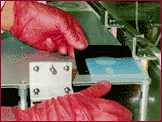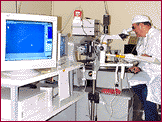





Objectives
The objectives of ODC were to non-destructively collect orbital debris and natural particles in low-Earth orbit (LEO), via low-density aerogel, and to return them to Earth for detailed mineralogical and compositional analyses. This information is indispensable to reconstruct the sources and origins of the hypervelocity particle environment in LEO, and to develop strategies for its potential mitigation. Man-made debris in LEO present a substantial collisional hazard to spacecraft. The damage to spacecraft can range from submicroscopic impact features, which can adversely affect critical subsystems, to the catastrophic fragmentation of entire spacecraft.
Shuttle-Mir Missions Approach
Once deployed, ODC, as was the case for all four MEEP experiments, required no crew interactions during their 18-month exposure. STS-86 astronauts S. Parazynski and V. Titov carried out retrieval operations on October 1, 1997, and all four MEEP experiments were returned to Earth for analysis.
Results
As of this writing (May, 1999) 24 ODC tiles (i.e., 12 from each tray) have been scanned in detail; from these scans, 631 features have met or exceeded our minimum size criteria (i.e., > 500 µm in size) and were documented in detail. Of these, 482 (~ 76%) were located on 12 tiles examined from Tray 2, while the remaining 149 (~ 24%) were found on Tray 1 tiles.
The detailed compositional analysis of ODC particles utilized Scanning Electron Microscope (SEM) methods combined with Energy Dispersive X-Ray Spectroscopy (EDS) to determine the major-element chemistry of the various impactors. These techniques have been applied to only a limited number of recovered particles to date. From this data, both man-made orbital debris and natural impactors have been identified.
Man-made particles include liquid droplets and soap flakes, that appear to have originated from water dumps during Shuttle-Mir operations, and paint, that are known from most other space-exposed surface. Thermal protective paints are prone to substantial abrasion by small-scale impacts, and their largely organic binders degrade when exposed to atomic oxygen and/or ultraviolet rays (UV). In addition stainless steel and Cu-rich particles reflect fragments of electronic components, some even associated with Ag from silver solders. Finally, two examples of essentially pure metallic aluminum were found that represent structurally disintegrated components of spacecraft, while only a single Al2O3 particle (i.e., solid-rocket exhaust) was discovered so far.
Particles believed to be of natural origins include a specimen of essentially pure iron oxide. It could be natural, such as isolated crystals of hematite (Fe2O3) or magnetite (Fe304), known to occur in meteorites, or it could be man-made iron that was oxidized (e.g., during explosive or impact-derived origins). The lack of any alloying component, such as Cr, W, or Ni argues against most popular steels and leads us to prefer a natural source. Other particles were composed of very fine-grained aggregates of submicron sized components consisting of modestly variable distributions of the dominant elements, Mg, Ca, and Fe, and substantial variations in minor elements, such as Al, S, or Ni. These compositions suggest such particles to be chondritic in nature and of natural origin. The EDS spectrum of another particle reveals the presence of mafic silicates (Fe, Mg, and Si), and most likely the presence of a K-rich feldpsar (Al and K). Transmission Electron Microscope (TEM) investigations of this particle revealed significant disruption of the parent grain by invading aerogel melt, the presence of hydrated layer-lattice silicates, and small (sub-micron) oxide grains. These particles represent the first natural cosmic-dust grains ever recovered from space-exposed aerogel collectors. Although a very modest effort in the context of ODC, the successful recovery and subsequent TEM analysis of space-retrieved particles is significant for planetary sciences, and specifically for the in-situ characterization of comets and asteroids, the most prominent sources of interplanetary dust.
The ODC component of the MEEP payload deployed by STS-76 on March 25, 1996 and retrieved by STS-86 on October 1, 1997 performed nominally, if not outstandingly. None of the delicate aerogel collectors was damaged during ground handling, launch, deployment, or retrieval. Every single tile contained some impact features, and projectile residues were clearly visible at the terminus of many penetration tracks. Macroscopic examination of all surfaces revealed the presence of various impact features: (1) classical carrot-shaped tracks, (2) relatively shallow pits that are poorly understood and have no experimental analogue, and (3) white flakes that are embedded into the aerogel surface. A unique swarm of particles, most likely the fine-grained ejecta of a nearby hypervelocity crater, affected the rearward facing surfaces of ODC. Both man-made and natural particles have been identified.
Prominently clustered tracks and spatially isolated features of similar size and orientation on Tray 2 demonstrate the presence of debris clouds and the production of sizable populations of impact features caused by secondary impacts on spacecraft. Such clouds may have distinctly heterogeneous mass distribution and contain particles of variable sizes. In this specific case a natural impactor encountered either some Mir structure at very shallow incidence, or it penetrated some thin membrane, such that only projectile fragments contributed to the secondary particle swarm.
In conclusion, although the optical analysis and sample preparation for detailed compositional analysis via SEM-EDS or TEM methods are more time consuming than for non-porous media, this apparent disadvantage is far outweighed by the ability to preserve and trap unmolten residues for most hypervelocity particles in LEO. Aerogel is unquestionably the best capture medium that is presently available. Unfortunately, neither conventional, non-porous collectors nor aerogel yield reliable dynamic data for individual particles, including chronological information of collisional events. Such dynamic and chronologic data are ultimately needed to understand the hypervelocity environment in LEO. Active instruments should be developed that measure the mass and trajectories of individual particles that, when combined with aerogel collectors, would provide unambiguous evidence to associate specific particles with either man-made sources and events, or with natural astrophysical sources.
Earth Benefits
By researching the types of particles, as well as the size, placement, and velocity of the particles that have encountered the Space Station Mir, it appears possible to identify ways to protect such objects against hypervelocity impacts in LEO. This includes laboratory studies to simulate impacts on new materials being considered for both the external structures of the International Space Station and new satellites. Second, it will be possible to verify previous mathematical models on the behavior and production of particles in the space environment. With such information at hand, new, more durable materials can be developed that will help protect spacecraft from possible catastrophic impacts, saving money, as well as lives.
Publications
Hörz, F., Cress, G., Zolensky, M., See, T.H., Bernhard, R.P., Warren, J.H. (1998) Macroscopic Inspection of the Orbital Debris Collection Experiment (30-Day Report).
Hörz, F. Cress, G, Zolensky, M., See, T.H., Bernhard, R.P., and Warren, J.L. (1999) Optical Analysis of Impact Features in Aerogel from the Orbital Debris Collection Experiment on the Mir Station, submitted as NASA Technical Memorandum, February, 1999.
Bernhard, R.P., See, T.H., and Hörz, F. (1999) Morphology of Impact Features in Space Exposed Aerogel (abstract), Lunar and Planetary Science XXX, 1916.
Bernhard, R.P., Warren, J, See, T.H., and Hörz, F. (1999) Optical Analysis of Aerogel Collectors Exposed on Mir (abstract), Lunar and Planetary Science XXX, 1806.
Principal Investigators Co-Investigators![]()
STS-76, NASA-2 - NASA-5, STS-86
The Mir Environmental Effects Package (MEEP), consisting of four individual containers, each housing a dedicated experiment, was launched on STS-76 on March 25, 1996. The MEEP containers were stored in Shuttle's cargo bay during both launch and landing of the Shuttles. Astronauts M.R. Clifford and L.M. Godwin deployed the MEEP instruments on March 27, 1996. A special clamping device allowed each of the MEEP containers to be mounted/attached to the handrails of the Shuttle's Docking Module on Mir. The ODC experiment utilized SiO2 aerogel as a capture medium to decelerate the incoming particles and reduce the heating and shock stresses such particles normally are subjected to when impacting a solid medium, as in the case of PPMD. The aerogel used in the ODC experiment was a translucent, extremely low-density (i.e., 0.02 g/cm3) material possessing a total sample weight of approximately 166 grams for all 72 tiles; individual tiles measured approximately 9.53 x 9.53 x 1.27 cm (http://setas-www.larc.nasa.gov/meep/odc.html).
Two distinct classes of hypervelocity impact features were observed in the ODC aerogel: slender, carrot-shaped tracks and substantially stubby, if not hemispherical pits. Features of intermediate morphologies between these dominant end-members suggest the presence of a morphologic continuum and of an evolutionary sequence from deep tracks to hemispherical pits. The absence of impactor residue, combined with the presence of distinctly glazed and translucent walls for most pits suggests that they formed - as a group - at higher impact velocities than the slender and very deep tracks, which are characterized by the needle like stylus, and a largely unmolten projectile remnant at the terminus of the track.
As the global community begins to rely more heavily on digital and electronic communications, Earth-orbiting structures like communications satellites have become increasingly important. These satellites provide pager, telephone, television, military intelligence, and news service around the world. Because of the great expense involved in placing such satellites in orbit, longevity is a necessity. In order to achieve such longevity, ways to enhance the external structure of satellites need to be developed.
Hörz, F., Zolensky, M., Cress, G., Bernhard, R.P., See, T.H., Warren, J.H., Brownlee, D.E., and Tsou, P. (1998) ODC Aerogel Particle Capture During 18 Moths Exposure on Mir (abstract), Lunar and Planetary Science XXIX, p. 1773-1774.
Freidrich Hörz, Ph.D.
NASA/Johnson Space Center
Glen Cress
Thomas H. See
Ronald P. Bernhard
![]()
|
|
Curator:
Julie Oliveaux
Responsible NASA Official: John Uri |
Page last updated: 07/16/1999
.gif)